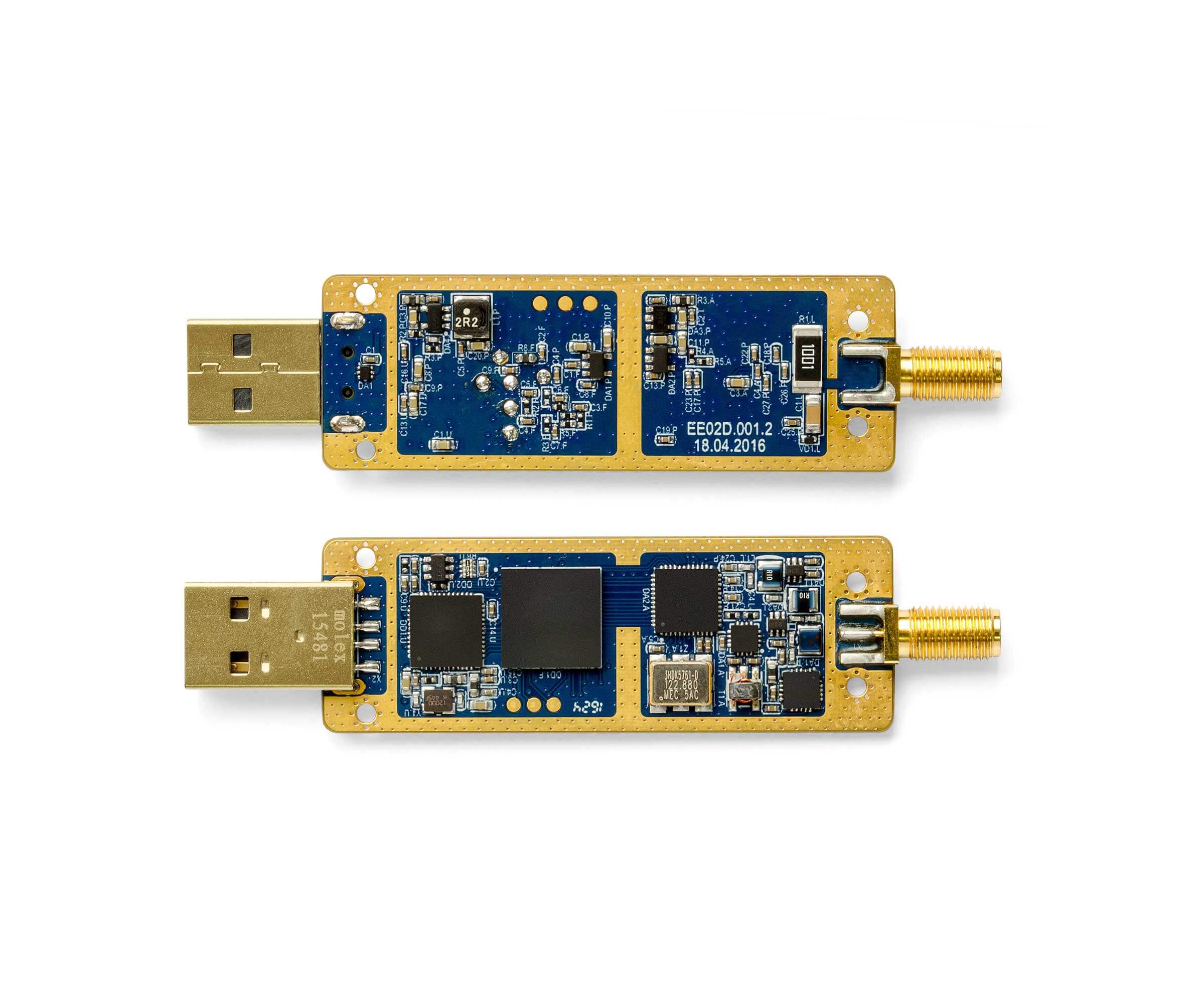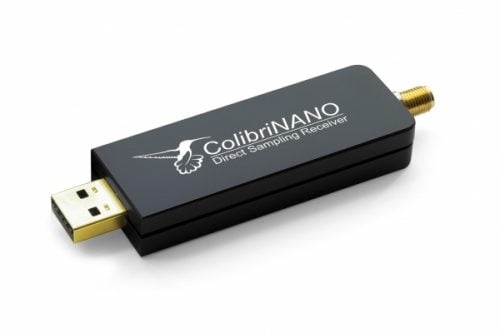ColibriNANO: A New 10 kHz to 500 MHz Direct Sampling Receiver
The ColibriNANO is a new software defined radio that is currently available for pre-order and is expected to be ready for delivery by the end of April 2017. The specs show that it is a direct sampling receiver (no tuner), which can receive from 10 kHz to 500 MHz in oversampling mode, and from 10 kHz to 55 MHz in standard mode. It uses a 14 Bit ADC which provides up to 110 dB’s of blocking dynamic range, and can run with a sampling rate of up to 3 MHz. The press release given to us reads:
New ColibriNANO SDR USB Receiver with a 14-bit ADC .01-500MHz
Kirkland, WA, USA —March 27 th , 2017 –
Vasily Vasiliev, Chief Hardware Engineer of Expert Electronics is pleased to announce availability of new ColibriNANO 0.01-500 MHz receiver in late April, 2017.
Notable features include the blocking dynamic range (BDR) ~110dB, native .01-55 MHz coverage with up to 500 MHz in oversampling mode, low pass filter (LPF) <60 MHz, full compatibility with HDSDR, legacy SDR#, and ExpertSDR2 software.
Supported platforms are Windows® XP-10, Linux and Web-client for HTML5 browsers.
No existing USB SDR receivers combine high sensitivity and broad dynamic range. Remote operation (TCP/IP) interface is built-in and offers plug-and- play solutions for Amateur, Commercial and Government applications.
For further information call (800)977-0448 or email [email protected]
https://www.nsiradio.com
Currently we see that the ColibriNANO is selling for $249.95 USD on the nsiradio.com website. We’ve also seen the following description on the sunsdr.eu website:
With the new ColibriNANO you will be able to enjoy LF, MW and Shortwave listening in many different ways. For example you can record the entire medium wave band using 1.5 MHz sampling rate, decode CW using CW skimmer, remote control the ColibriNANO by plugging it into our RPI server. There are an endless range of applications for this small SDR. All this in a tiny USB stick!
The ColibriNANO features a Texas Instruments ADS4145 14 bit direct sampling ADC and a built in low 55 MHz pass filter that can be bypassed to receive signals up to 500 MHz (external filters like the our 2m filtered preamp recommended).
CW skimmer and Skimmer With the external ExtIO library the ColibriNANO can be used with third party software like HDSDR etc.
This is not a cheap USB dongle found on Ebay, this high quality SDR receiver is developed by Expert Electronics and features a sturdy aluminium chassis, ESD protection, USB 2.0 interface and a quality SMA antenna connector.
Best of all, the ColibriNANO travels in your pocket and only needs your computer and an antenna! Its the ultimate portable SDR receiver!
Software support
- ExpertSDR2
- CW Skimmer
- Skimmer Server
- Third party software using ExtIO library
Specifications
- Receiving bandwidth: 0.1 – 55 MHz
- Oversampling receiving: 0.1 – 500 MHz
- Blocking Dynamic Range (BDR): 110 dB
- Sensitivity: 0.05 uV at 20M band, preamp = 0
- IMD3 Dynamic Range: 95 dB
- ADC resolution: 14-bit @ 122.88 MHz
- Sample rate: 48, 96, 192, 384, 768 kHz and 1.5, 3.0 MHz
- IQ resolution: 24 bit (16 bit at 1.5 and 3 MHz sample rates)
- RF Input: (SMA connector, up to 15kV ESD protection)
- Preamp range: from 31.5 up to +6 dB with 0.5 dB steps
- Operating temperature: -10°C to 60°C
- Dimensions: 90х25х17mm
- Weight: 0.043kg
It looks like that this receiver may compete somewhat with the also upcoming Airspy HF+. The Airspy HF+ claims similar specs including a frequency range of 0 – 270 MHz, 14 Bit ADC and 108 dB blocking dynamic range. But the target price for the HF+ is below $200 USD.








Well, articlean amateur radio operator and SDR enthusiest also reading the QST article on this unit, my say is it is FAR OVER PRICED and will crash sales wise in the market place. 73 KV4WM
The ColibriNano has the same engine how “Colibri”! I think it has the same problems: Big FM-Signals are killed the reception very strong, if you had no presection. And no place for it is in case.
I burned my money in other thinks…
Well I guess I will add my two cents to this , after about three years of messing around with direct sampling I have come to understand some things about the system . One , the front end will pickup strong signals that are out of band ramification , should they be their or not . Two no control over the RF coming in , it be to weak to hear anything , or to strong and over drive the a to d chip . Now ColibriNANO doesn’t say anything about their front end , it is a mystery . I have found a way to over come these short comings and that is to use a amplified preselector with a gain control . I use a MFJ-1020C it works quite well . The downside is that it runs about $ 100.00 usd , plus the price of the SDR it could get expensive .
Hello Robert,
What is your recommended cheap SDR bang for the buck?
Hi Roel .
Well it comes down to what you want to spend The RTL-SDR and a MFJ 1020C is the cheapest way to go , about $ 125.00 Now if you want to do some real DXing go with the airspy HF+ is the best bang for the buck .
It runs at $200.00 and that is the only thing you would need .
From an OBJECTIVE standpoint, considering price and performance, would you go for the Colibri or the Airspy HF+ (or the RSP2) ?
OBJECTIVE, by what criteria ?
People can only compare the on paper specifications of two of the devices you named, the hardware is not in peoples hands (yet). If you were living in a RF wasteland like the Antarctica, your criteria would be totally different to someone living 200 meters from a FM radio transmitter. Objective requires some constraints, but If I read between the lines of the devices you have selected to compare then I can assume that part of the RF spectrum primarily of interested to you is RX only for 31MHz down all the way to DC ? And since you decided to put this post on the Colibri that suggests that you have already decided that you have ~$250 burning a hole in your pocket waiting to be spent.
The real problem is that the hardware is only half the story, there is a very big S in SDR, the very best performance is usually gained from the software provided by the maker of the hardware. Me personally I would wait, if you can, until all the hardware is out in the wild, or at least prototypes in the hands of ham magazines (The ColibriNANO board shown above is dated 16th of March 2016, I find it hard to believe that would actually be the final revision of the board that will ship, but maybe it is).
There is also a problem in waiting, far more juicy hardware will appear, to drool over.
Objective meant without any prejudice to a particular brand, product or person.
<>
I selected these 3 devices because their prices are similar. My main interests are LF/MW and FM/2m (RX only)
<>
Who told you that ? I simply find out about the products and shall then decide whether it’s worth buying something or not. I already own an ELAD S2 and some cheap dongles.
As for the “S”, SDR# will most probably be OK with the HF+ just as SDRuno seems fine when running the RSP. No idea though about ColibriNano, but I assume SDR Console v3 will do the trick.
Well we’re getting there for sure. But price to value wise this is not even in the ball park, sorry. At $100-125 ish USD it would be a buy, buy, buy, no brainer. Sadly we’re starting to see the “old style” of thinking in the RF/Ham radio sales dept of; what else is there? So ya you’ll pay what we want to sell it for, and sadly with a “new” widget popping up almost every 3 months now its just not justified. IMHO.
In the picture that is provided here I see that the ground is not connected to the SMA connector nor is it connected to the shield of the UBS connector . I wounder why that is ????????????
It’s probably connected to an analog ground plane thus separating the analog/digital/chassis grounds.
Looks like my post was cancelled …
Why ???
Sorry, I had a refresh issue.
The article states :”The Airspy HF+ claims similar specs including a frequency range of 0 – 270 MHz, 14 Bit ADC”
Isn’t the HF+ a 18 bits ADC ?
ColibriNANO : 14-bit @ 122.88 MHz
AirspyHF+: 18-bit @ 600kHz
If you decimate 122.88MHz by 4^4 to gain an extra 4-bits of dynamic range and make the comparison easier to understand then you have 18-bit @ 480kHz. And then you would need to half that because there is only one input channel in the ADC so it would be 18-bit @ 240 kHz
Then are in the same general region.
I do not think it was mentioned what the the exact ADC is inside the AirspyHF+, only that after DDC (Digital down converter) that it was 18-bit @ 600kHz
Looking back they do mention “2 x High Dynamic Range Sigma Delta ADCs @ 36 MSPS” which I think would imply 15-bit ? Would that be right ?
36000000 @ ? bit
9000000 @ ? bit +1
2250000 @ ? bit +2
562500 @ ? bit +3 ~= 600kHz @ 18-bit
You may want to change “IQ resolution: 24 bit (16 bit at 1.5 and 3 MHz sample rates)”, because they do not claim 24-bits they only claim that the size of the stream that they use is 24 bits, even though 4 of those bits will always be zero.